|

The
Acropolis Museum
The
Acropolis Museum (1866-1873) stands in the south eastern
corner of the sacred rock and houses finds from excavations
on the Acropolis. There are nine galleries in all
which display, in chronological order, the strides forward
made by art in the most brilliant period of Athenian
history.
There are two
periods of Greek art which are glorified on the Acropolis,
the Archaic and the Classical. By strange good
fortune, disaster salvaged the former for us. In 480
BCE, the Persians occupied Athens for a short period of time
demolishing the treasures of the Acropolis. When the victorious
Athenians returned shortly afterwards, the ruins were
buried with reverence in hollows in the rock where they
remained forgotten for centuries, thus avoiding the
disasters and thefts which subsequently laid waste the
Acropolis.
The classical
votives did not have the same luck. Very important statues
of bronze and marble, works of the best known artists of
antiquity have been lost forever. Their existence is
known only from the precious description of the traveler
Pausanias (middle of the 2nd century CE).
Fortunately, several of the sculptures which adorned the
monuments have survived from this period. Most have
been taken abroad, mainly to the British Museum, part of
them are still in-situ on the monuments and others are on
display in the Acropolis Museum.
Click on the thumbnails below in order to see pictures of the Acropolis Museum.
Use your browser's back button
to return to this page. The exhibits are arranged in roughly chronological
order, archaic to classical periods.

|
|
|
|
|
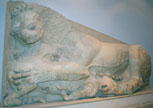 Lioness
killing a cow from the decoration of the pediment of a large poros temple
of circa 600 BCE, perhaps the first post-Geometric phase of the so-called
"Old Temple" of Athena Polias. Lioness
killing a cow from the decoration of the pediment of a large poros temple
of circa 600 BCE, perhaps the first post-Geometric phase of the so-called
"Old Temple" of Athena Polias. |
|
 Head
and small part of the body of a marble Gorgon. The Gorgon was the acroterium of a large temple
from the beginning of the 6th century BCE, perhaps the Old
Temple of Athena. Head
and small part of the body of a marble Gorgon. The Gorgon was the acroterium of a large temple
from the beginning of the 6th century BCE, perhaps the Old
Temple of Athena. |
|
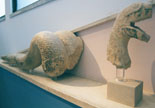 Large
snake from the decoration of the rear frieze of the large temple. Large
snake from the decoration of the rear frieze of the large temple. |
|
|
|
|
|

Hercules
wrestling with a Triton (a sea demon half man, half fish) on the left extremity of the composition
of the pediment from a large temple of the beginning of the 6th
century BCE, perhaps the Old Temple of Athena. |
|
 This
is Nereas, demon of the watery element who was continually changing
shape. It's portrayed here as a winged, three bodied demon with a
serpent's tail on the right extremity of the same pediment at left. Each of the three demons holds a symbol in its hands, water, fire and a
bird (a symbol of air). This
is Nereas, demon of the watery element who was continually changing
shape. It's portrayed here as a winged, three bodied demon with a
serpent's tail on the right extremity of the same pediment at left. Each of the three demons holds a symbol in its hands, water, fire and a
bird (a symbol of air). |
|
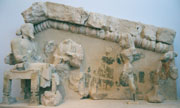
The
narrative style of this period is admirably represented by the pediment of
the deification of Hercules on Olympus. Zeus majestically seated
with Hera at his side received the mighty hero on Olympus. The
temple which was the source of this pediment is unknown. |
|
|
|
|
|
 The
marble Moschophoros (calf-bearer) dated to 570 BCE. According to the
inscription on its base, it was offered by Romvos, certainly a noble man
from the countryside, who is portrayed advancing joyfully to proffer his calf to Athena.
Eyes full of light and a deeply human smile give life to his innocent
face. The
marble Moschophoros (calf-bearer) dated to 570 BCE. According to the
inscription on its base, it was offered by Romvos, certainly a noble man
from the countryside, who is portrayed advancing joyfully to proffer his calf to Athena.
Eyes full of light and a deeply human smile give life to his innocent
face. |
|
 Marble
quadriga (four-horse chariot), 'ex voto' of 570 BCE. Marble
quadriga (four-horse chariot), 'ex voto' of 570 BCE. |
|
 The
Persian Rider, a marble
horseman of 560-550 BCE. During the archaic period, statues of horsemen
were a significant class of dedications made in the sanctuary of Athena.
The reasons for making these dedications are not known. Perhaps they were
offerings made by knights, i.e. the second highest class in Athenian
society during the archaic period. The
Persian Rider, a marble
horseman of 560-550 BCE. During the archaic period, statues of horsemen
were a significant class of dedications made in the sanctuary of Athena.
The reasons for making these dedications are not known. Perhaps they were
offerings made by knights, i.e. the second highest class in Athenian
society during the archaic period.
|
|
|
|
|
|
 Two
lions killing a bull from the center of the pediment of the Old
Temple of Athena. They occupied the center of the same pediment on which
Hercules and the Triton as well as the three bodied demon occupied the two
corners. The subject is of the same quality as that of the corners
but differs in that this composition, being later than the other, is less
constricted. The bodies are more realistic and the movement faster
and more violent, the realism almost raw. Two
lions killing a bull from the center of the pediment of the Old
Temple of Athena. They occupied the center of the same pediment on which
Hercules and the Triton as well as the three bodied demon occupied the two
corners. The subject is of the same quality as that of the corners
but differs in that this composition, being later than the other, is less
constricted. The bodies are more realistic and the movement faster
and more violent, the realism almost raw. |
|
 Marble
sphinx of 560 BCE. Marble
sphinx of 560 BCE. |
|
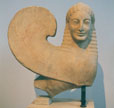 Marble
sphinx of 540 BCE. Marble
sphinx of 540 BCE.
|
|
|
|
|
|
 Marble
kore, usually referred to as the Peplophoros, or Peplos Kore, on account of the peplos, a
simple unpleated garment of Doric provenance, which she is wearing. Superior, with its phenomenally rigid stance, radiant face, eyes full of
light, finely chiseled face, this work of circa 525 BCE must have come from
the chisel of a great artist of the era. There are still traces of color preserved on
her eyes, lips and curly hair, which was held by a metal diadem. Marble
kore, usually referred to as the Peplophoros, or Peplos Kore, on account of the peplos, a
simple unpleated garment of Doric provenance, which she is wearing. Superior, with its phenomenally rigid stance, radiant face, eyes full of
light, finely chiseled face, this work of circa 525 BCE must have come from
the chisel of a great artist of the era. There are still traces of color preserved on
her eyes, lips and curly hair, which was held by a metal diadem. |
|
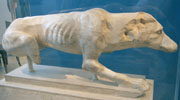 Lifelike
marble hunting dog (530 - 520 BCE) presumed to have guarded the sanctuary
of Brauronian Artemis, attributed to the same artist as the Peplophoros. Lifelike
marble hunting dog (530 - 520 BCE) presumed to have guarded the sanctuary
of Brauronian Artemis, attributed to the same artist as the Peplophoros. |
|
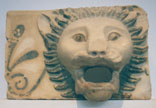 Marble
lion head waterspout from the Old Temple of Athena, just south of the
Erechtheion, which the sons of Peisistratos rebuilt in honor of Athena
around 525 BCE (3rd post-Geometric phase). The lion head, its savage
expression strikingly rendered, is vividly painted on the mane, jaws, and eyes
and framed by a painted palmetto. Marble
lion head waterspout from the Old Temple of Athena, just south of the
Erechtheion, which the sons of Peisistratos rebuilt in honor of Athena
around 525 BCE (3rd post-Geometric phase). The lion head, its savage
expression strikingly rendered, is vividly painted on the mane, jaws, and eyes
and framed by a painted palmetto. |
|
|
|
|
|
 Large
marble Athena from the pediment bearing a representation of
Gigantomachy from the Old
Temple, as it was renovated in 525 BCE by the sons of Peisistratos (3rd
phase of the Old Temple). The pediment represents the battle of the
Olympian gods with the Giants. Athena is portrayed launching into
battle with a wide stride, allowing her terrifying aegis with its snakes
to billow as she stoops over an opponent to deliver the final blow. Large
marble Athena from the pediment bearing a representation of
Gigantomachy from the Old
Temple, as it was renovated in 525 BCE by the sons of Peisistratos (3rd
phase of the Old Temple). The pediment represents the battle of the
Olympian gods with the Giants. Athena is portrayed launching into
battle with a wide stride, allowing her terrifying aegis with its snakes
to billow as she stoops over an opponent to deliver the final blow. |
|
 Marble
kore of 510 BCE, perhaps of Peloponnesian workmanship. The kores are simply votive statues of young maidens
that brought pleasure to the goddess who was evidently more delighted with
these offerings than with any other. They do not depict specific
persons nor are they exclusively female votives. Marble
kore of 510 BCE, perhaps of Peloponnesian workmanship. The kores are simply votive statues of young maidens
that brought pleasure to the goddess who was evidently more delighted with
these offerings than with any other. They do not depict specific
persons nor are they exclusively female votives. |
|
 Marble
kore of 500 BCE. The korai (young maiden kores as opposed to kouroi,
the young males) are clothed in rich robes and with their hair elaborately
dressed. They stand straight and with the facial expression typical
of Archaic art (the Archaic smile). In one hand, they hold offerings
(flowers, birds, fruit) while the other raises their dress. Marble
kore of 500 BCE. The korai (young maiden kores as opposed to kouroi,
the young males) are clothed in rich robes and with their hair elaborately
dressed. They stand straight and with the facial expression typical
of Archaic art (the Archaic smile). In one hand, they hold offerings
(flowers, birds, fruit) while the other raises their dress. |
|
|
|
|
|
|
 The
Kritios Boy, a very
beautiful marble statue of an ephebe athlete, certainly the victor in some
contest. The Archaic conception of the supporting of the body on
both feet has been abandoned. The right limb has been freed, the
body turned to the same side as the inclined head and the expression is
serious. Classical art commences with the "severe style". Work of 480 BCE
attributed to the sculptor, Kritios, the teacher of Myron. The
Kritios Boy, a very
beautiful marble statue of an ephebe athlete, certainly the victor in some
contest. The Archaic conception of the supporting of the body on
both feet has been abandoned. The right limb has been freed, the
body turned to the same side as the inclined head and the expression is
serious. Classical art commences with the "severe style". Work of 480 BCE
attributed to the sculptor, Kritios, the teacher of Myron.
|
|
 The
votive
relief of Athena, who leans on her spear with her head inclined pensively,
is one of the most famous and yet most unpretentious works. It has
an aura of finesse, sensitivity and austerity. The goddess is clad in an
Attic peplos with a belt and slightly bends her head towards the stele
depicted in front of her. Work of 460 BCE. The
votive
relief of Athena, who leans on her spear with her head inclined pensively,
is one of the most famous and yet most unpretentious works. It has
an aura of finesse, sensitivity and austerity. The goddess is clad in an
Attic peplos with a belt and slightly bends her head towards the stele
depicted in front of her. Work of 460 BCE.
|
|
 Nike
unloosening her sandal. The relief is from the parapet of the
bastion of the temple of Athena Nike. Dated to circa 410 BCE. Nike
unloosening her sandal. The relief is from the parapet of the
bastion of the temple of Athena Nike. Dated to circa 410 BCE. |
|
|
|
|
|
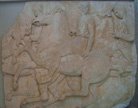 A
portion of the Parthenon
frieze. Chariot and apobates (slaves
riding the chariot horses) are depicted as part of the Panathenaic
Procession. A
portion of the Parthenon
frieze. Chariot and apobates (slaves
riding the chariot horses) are depicted as part of the Panathenaic
Procession. |
|
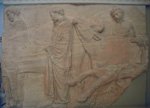 A
youth leading a cow to sacrifice from the Parthenon's north frieze. A
youth leading a cow to sacrifice from the Parthenon's north frieze. |
|
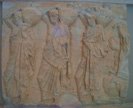 Young
pitcher bearers (hydriaphoroi) from the Parthenon frieze. Young
pitcher bearers (hydriaphoroi) from the Parthenon frieze.
|
|
|
|
|
|
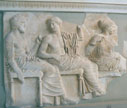 Section
of the eastern Ionic frieze which ran around the Parthenon inside
the peristyle. A masterpiece of the
sculptor Phidias, this depicted - on a surface with a total length of 160
meters - the most important religious ceremony to take place in Athens: the
Panathenaic Procession. The Great Panathenaea was held every four years in
honor of Athena Polias and culminated with the symbolic endowment of the
wooden cult statue of Athena Polias in the Erechtheum with a new
robe. From the left,
Poseidon, Apollo and Artemis watch the presentation of the 'peplos' to the
statue of Athena. Section
of the eastern Ionic frieze which ran around the Parthenon inside
the peristyle. A masterpiece of the
sculptor Phidias, this depicted - on a surface with a total length of 160
meters - the most important religious ceremony to take place in Athens: the
Panathenaic Procession. The Great Panathenaea was held every four years in
honor of Athena Polias and culminated with the symbolic endowment of the
wooden cult statue of Athena Polias in the Erechtheum with a new
robe. From the left,
Poseidon, Apollo and Artemis watch the presentation of the 'peplos' to the
statue of Athena. |
|
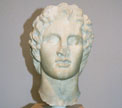 Head
of Alexander the Great. The Macedonian king is represented as a
youth with luxuriantly wavy locks which rise upward from above the middle
of his forehead like a lion's mane, a characteristic known from all
Alexander portraits. Probably an original work of the sculpture,
Leochares, carved around 330 BCE. Head
of Alexander the Great. The Macedonian king is represented as a
youth with luxuriantly wavy locks which rise upward from above the middle
of his forehead like a lion's mane, a characteristic known from all
Alexander portraits. Probably an original work of the sculpture,
Leochares, carved around 330 BCE.
|
|
|
|
|
|
|
|
© All pictures are Copyright 2000 Grisel Gonzalez and Jeff
Prosise
|